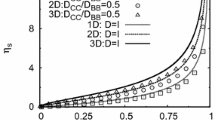Abstract
The author’s initial treatment of diffusion controlled precipitate growth in isothermal ternary systems is generalized to account for ternary diffusional interaction. The analysis is applicable to the growth of planar surfaces, circular cylinders, and spheres in an effectively infinite matrix. It is assumed that one independent component diffuses at least an order of magnitude faster than the other. The resultant growth rate expressions have a surprisingly simple form from which kinetic and thermodynamic implications are easily extracted. Because of its relevance to austenite decomposition reactions in alloy steels, the limit in which one independent component diffuses many orders of magnitude faster than the other is examined in detail. It is demonstrated that in this limit, the present essentially kinetic analysis is completely consistent with thermodynamic concepts proposed by Hillert.
Similar content being viewed by others
References
D. E.Coates:Met. Trans., 1972, vol. 3, pp. 1203–12.
G. R. Purdy, D. H. Wdchert, and J. S. Kirkaldy:Trans. TMS-A1ME, 1964, vol. 230, pp. 1025–34.
G. V. Shcherbedinskiy and L. A. Kondrachenko:Phys. Metals Metallog., 1970, vol. 30, no. 4, pp. 13–21.
L. Onsager:Ann. N. Y. Acad. Sci., 1945, vol. 46, pp. 241–65.
J. S. Kirkaldy, D. Weichert, and Zia-Ul-Haq:Can. J. Phys., 1963, vol. 41, pp. 2166–73.
J. S. Kirkaldy:Can. J. Phys., 1958, vol. 36, pp. 907–16.
F.C. Frank:Proc. Roy. Soc, 1950, vol. A201, pp. 586–99.
C. Zener:J. Appl. Phys., 1949, vol. 20, pp. 950–53.
M. Abramowitz and I. A. Stegun, eds.:Handbook of Mathematical Functions, National Bureau of Standards, Washington, 1964.
F. S. Ham:Quart. Appl. Math., 1959, vol. 17, pp. 137–50.
G. Bolze, D. E. Coates, and J. S. Kirkaldy:Trans. ASM, 1969, vol. 62, pp. 794- 803.
M. Hillert: inThe Mechanism of Phase Transformations in Crystalline Solids, pp. 231–47, Inst. of Metals, London, 1969.
C. Wagner:Thermodynamics of Alloys, p. 53, Addison-Wesley, Reading, 1952.
L. C. Brown and J. S. Kirkaldy:Trans. TMS-AIME, 1964, vol. 230, pp. 223–26.
J. B. Gilmour, G. R. Purdy, and J. S. Kirkaldy:Met. Trans., 1972, vol. 3, pp. 1455–64.
J. S. Kirkaldy and G. R. Purdy:Can. J. Phys., 1962, vol. 40, pp. 208–17.
M. Hillert: Int. Rep., Swedish Inst. Metal Research, 1953.
Author information
Authors and Affiliations
Rights and permissions
About this article
Cite this article
Coates, D.E. Diffusion controlled precipitate growth in ternary systems: II. Metall Trans 4, 1077–1086 (1973). https://doi.org/10.1007/BF02645611
Received:
Issue Date:
DOI: https://doi.org/10.1007/BF02645611




